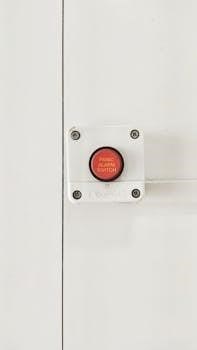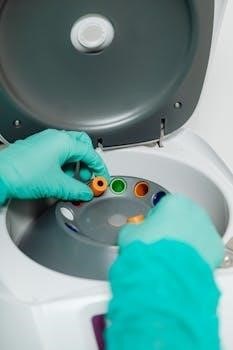Carel Controller User Manual⁚ A Comprehensive Guide
This comprehensive guide serves as your primary resource for effectively utilizing Carel controllers․ It provides essential instructions for installation, operation, and troubleshooting․ This manual covers various models, parameter configurations, and safety protocols․ Refer to this document for optimal performance and longevity of your Carel devices․
Carel controllers represent advanced technological solutions for precise control in various applications, primarily within refrigeration, air conditioning, and heating systems․ These microprocessor-based controllers offer sophisticated algorithms and parameter adjustments, enabling users to optimize system performance and energy efficiency․ Carel’s product line includes several series, such as the Easy series, pCO series, and IR33 controllers, each designed with specific features and functionalities to cater to different control requirements․
Effective utilization of Carel controllers necessitates a thorough understanding of their capabilities and programming interfaces․ The user manual serves as an indispensable tool, providing detailed instructions on parameter configuration, sensor connections, and troubleshooting procedures․ Proper installation and setup, guided by the manual, are crucial to minimizing measurement errors and ensuring accurate system control․
Furthermore, Carel controllers incorporate safety parameters and priorities to protect equipment and prevent operational hazards․ Understanding and configuring these safety features is paramount for reliable and safe operation․ With regular reference to the user manual, operators can unlock the full potential of Carel controllers and achieve optimal system performance․
Understanding the Purpose of a User Manual
The user manual for Carel controllers serves as a comprehensive guide, designed to equip users with the knowledge and instructions necessary for effective operation, configuration, and maintenance of their control systems․ Its primary purpose is to bridge the gap between the controller’s sophisticated technology and the user’s understanding, ensuring optimal performance and longevity of the equipment․
Within its pages, the manual provides detailed explanations of parameter settings, wiring diagrams, and troubleshooting procedures․ Users can leverage this information to accurately configure the controller to their specific application requirements, maximizing energy efficiency and system stability․ The manual also includes safety guidelines, highlighting critical precautions to prevent damage to equipment or personal injury․
Furthermore, the user manual acts as a valuable resource for resolving operational issues․ It offers step-by-step instructions for diagnosing and correcting common problems, minimizing downtime and reducing the need for costly repairs․ By carefully studying and referencing the user manual, operators can unlock the full potential of their Carel controllers and ensure reliable, efficient, and safe system operation․ It is an indispensable tool for both novice and experienced users․
Common Carel Controller Models
Carel offers a diverse range of controllers tailored to various applications within the HVACR industry․ Among the most prevalent models are the Easy series, designed for straightforward refrigeration control with user-friendly interfaces․ These controllers often feature pre-set parameters and simplified operation, making them suitable for basic applications․
The pCO series represents a more advanced line, offering extensive programmability and communication capabilities․ pCO controllers are commonly employed in complex systems requiring precise control and monitoring, such as chiller plants and large refrigeration installations․ Their flexibility allows for customization and integration with building management systems․
Another notable model is the IR33 controller, frequently utilized in smaller refrigeration units and display cases․ The IR33 provides essential control functions with a compact design and easy parameter adjustment․ Its reliability and affordability make it a popular choice for commercial refrigeration applications․
These models, along with others in the Carel portfolio, demonstrate the company’s commitment to providing versatile and innovative control solutions․ Each series is designed with specific features and capabilities to address the diverse needs of the HVACR market, ensuring optimal performance and energy efficiency․
Easy Series Controllers⁚ Features and Operation
The Carel Easy series controllers are designed for user-friendliness, focusing on simplicity and ease of operation in basic refrigeration applications․ These controllers typically feature a straightforward interface with a clear LED display, allowing users to quickly monitor and adjust key parameters․ The Easy series is ideal for applications where advanced programming is not required, such as display cases, small cold rooms, and vending machines․
Key features of the Easy series include pre-set parameter configurations, simplifying installation and setup․ Users can often select from a range of pre-defined application profiles, optimizing the controller’s performance for specific refrigeration systems․ The controllers typically support NTC temperature sensors, providing accurate temperature readings for precise control․
Operation of the Easy series is intuitive, with simple button controls for adjusting setpoints, defrost cycles, and fan operation․ Error handling is also streamlined, with clear alarm indicators to alert users to potential issues․ While the Easy series offers limited programmability compared to more advanced controllers, its simplicity and reliability make it a popular choice for basic refrigeration control needs․
The compact design of Easy series controllers allows for easy integration into existing refrigeration systems․ They are a cost-effective solution for maintaining optimal temperature control in a variety of commercial refrigeration applications․

pCO Series Controllers⁚ Advanced Functionality
The Carel pCO series controllers represent a significant step up in functionality and complexity, offering advanced control capabilities for sophisticated refrigeration and HVAC systems․ These controllers are designed to manage complex systems with multiple components, such as compressors, fans, valves, and heaters, providing precise and efficient operation․
A key feature of the pCO series is its programmable logic, allowing users to customize the controller’s behavior to meet the specific requirements of their application․ This is achieved through a powerful programming environment, enabling the creation of custom control algorithms and sequences․ The pCO series supports a wide range of communication protocols, facilitating integration with building management systems (BMS) and other control devices․
The pCO series controllers offer advanced monitoring and diagnostic capabilities, providing detailed information on system performance and potential issues․ This includes real-time data logging, alarm management, and remote access for monitoring and control․ The controllers also support advanced control strategies, such as adaptive defrost, energy optimization, and predictive maintenance․
With their advanced features and flexibility, the Carel pCO series controllers are ideal for demanding applications requiring precise control, energy efficiency, and comprehensive monitoring․ They are commonly used in large refrigeration systems, air conditioning units, and industrial process control applications․
IR33 Controller⁚ Parameter Overview
The Carel IR33 controller is a versatile and widely used electronic microprocessor controller designed for managing refrigeration and temperature control applications․ Understanding its parameter set is crucial for effective configuration and operation․ This section provides an overview of the key parameters available within the IR33 controller, enabling users to tailor its functionality to specific needs․
The IR33’s parameters are organized into functional blocks, each addressing a specific aspect of the controller’s operation․ These blocks typically include parameters for temperature setpoint, differential, defrost control, fan management, alarm settings, and input/output configurations․ Each parameter is identified by a unique code, allowing for easy reference and modification․
The parameter overview includes a description of each parameter’s function, its available range of values, and its default setting․ Understanding the impact of each parameter on the controller’s behavior is essential for optimizing system performance and ensuring reliable operation․ The manual provides detailed explanations of how to modify parameters and store the new values․
By carefully reviewing the IR33 controller’s parameter overview, users can gain a comprehensive understanding of its capabilities and configure it to meet the precise requirements of their application․ This will lead to improved system efficiency, enhanced temperature control, and reduced energy consumption․

Parameter Configuration and Adjustment
Configuring and adjusting parameters on Carel controllers is a critical step in tailoring the device to specific application requirements․ This process involves accessing the parameter menu, navigating through the available options, and modifying values according to the desired functionality․ Understanding the proper procedures and precautions is essential to avoid unintended consequences and ensure optimal system performance․
Before making any changes, it’s crucial to consult the controller’s user manual to understand the function and impact of each parameter․ Incorrect settings can lead to inefficient operation, system instability, or even damage to connected equipment․ Always document the original parameter values before making any modifications, allowing for easy restoration if needed․
The parameter adjustment process typically involves using the controller’s keypad or a connected programming tool․ Navigate to the desired parameter using the arrow keys or menu options, and then modify the value using the appropriate input method․ Ensure that the new value falls within the specified range for that parameter․

After making changes, it’s essential to save the new settings to the controller’s memory․ This usually involves pressing a designated “save” or “enter” key․ Verify that the changes have been successfully applied by checking the parameter value again after saving․ Finally, thoroughly test the system to ensure that the modified parameters are functioning as expected․
Sensor Selection and Connection
Selecting the appropriate sensors and connecting them correctly to the Carel controller are fundamental steps for accurate and reliable system operation․ The type of sensor required depends on the specific application and the parameters being monitored, such as temperature, pressure, or humidity․ Carel controllers typically support a variety of sensor types, including NTC thermistors, PT100/PT1000 RTDs, and 4-20mA transducers․
When selecting a sensor, it’s crucial to consider its accuracy, range, and environmental suitability․ Ensure that the sensor’s specifications meet the requirements of the application and that it is compatible with the Carel controller․ Refer to the controller’s user manual for a list of supported sensor types and their corresponding connection parameters․
Proper sensor connection is essential for accurate data transmission and to prevent damage to the controller or sensor․ Follow the wiring diagrams provided in the controller’s manual carefully, paying close attention to polarity and pin assignments․ Use appropriate wiring techniques and connectors to ensure a secure and reliable connection․ Avoid loose connections or exposed wires, as these can lead to inaccurate readings or system malfunctions․
After connecting the sensors, verify their functionality by checking the sensor readings on the controller’s display or through a connected monitoring system․ If the readings are inaccurate or unstable, check the sensor connections, wiring, and sensor parameters in the controller’s configuration settings․ Proper sensor selection and connection are vital for accurate system control and reliable performance․
Error Handling and Troubleshooting
Carel controllers incorporate robust error handling mechanisms to detect and alert users to potential issues within the controlled system․ When an error occurs, the controller typically displays an error code or message on its screen, providing valuable information for diagnosing the problem․ Refer to the controller’s user manual for a comprehensive list of error codes and their corresponding meanings․
Troubleshooting Carel controllers involves systematically investigating the cause of the error and implementing appropriate corrective actions․ Start by noting the error code and the conditions under which the error occurred․ Consult the user manual for possible causes and suggested remedies․ Check the sensor connections, wiring, and power supply to ensure they are functioning correctly․ Verify that the controller’s parameters are configured correctly and that they are appropriate for the application․
If the error persists, consider using diagnostic tools or software provided by Carel to further analyze the system’s performance․ These tools can provide more detailed information about the controller’s internal state and the behavior of connected devices․ If you are unable to resolve the issue on your own, contact a qualified technician or Carel’s technical support team for assistance․
Regularly monitor the controller’s performance and proactively address any potential issues to prevent system downtime and ensure optimal operation․ Keep the controller’s firmware up to date to benefit from the latest bug fixes and performance improvements․ By following these guidelines, you can effectively troubleshoot Carel controllers and maintain a reliable and efficient control system․
Defrost Parameter Settings
Defrost parameter settings are crucial for efficient operation of refrigeration systems controlled by Carel devices․ These settings dictate how and when the defrost cycle initiates and terminates, directly impacting energy consumption and product preservation․ Incorrect settings can lead to excessive ice buildup, reduced cooling capacity, and potential damage to the evaporator coil․
Key defrost parameters include defrost duration, defrost frequency, termination temperature, and defrost method․ Defrost duration determines the length of the defrost cycle, while defrost frequency specifies how often defrosting occurs․ Termination temperature sets the temperature at which the defrost cycle ends, preventing overheating of the evaporator coil․ The defrost method can be either electric, hot gas, or air defrost, depending on the system’s design․
When configuring defrost parameters, consider the specific requirements of the application, such as the type of product being stored, the ambient temperature, and the humidity level․ Adjust the parameters to minimize energy consumption while ensuring effective ice removal․ Regularly monitor the system’s performance and make adjustments as needed to optimize defrost cycles․
Carel controllers often include advanced defrost features, such as adaptive defrost, which automatically adjusts defrost parameters based on real-time conditions․ Utilizing these features can further improve energy efficiency and system performance․ Always refer to the Carel controller’s user manual for detailed instructions on configuring defrost parameters and utilizing advanced defrost features․ Understanding and properly configuring these settings is essential for maintaining a reliable and efficient refrigeration system․
Using Programming Keys for Configuration
Programming keys offer a convenient and efficient method for configuring Carel controllers, particularly when dealing with multiple units requiring identical settings․ These keys, like the Carel PSOPZKEY00, allow users to quickly copy parameter configurations from one controller to another, significantly reducing setup time and ensuring consistency across the system․
The programming process typically involves connecting the key to a master controller, uploading the desired parameter settings, and then transferring those settings to other controllers․ This eliminates the need to manually configure each controller individually, minimizing the risk of errors and saving valuable time, especially in large installations․ Before using a programming key, ensure it is compatible with the specific Carel controller model․

To use the programming key effectively, carefully follow the instructions provided in the Carel controller’s user manual․ The manual will detail the proper connection procedure, the steps for uploading and downloading parameters, and any specific precautions to observe․ It’s crucial to ensure that the controller is powered on and in the correct mode before attempting to transfer settings․
Programming keys can also be used to store backup configurations, providing a safeguard against data loss or accidental parameter changes․ Regularly backing up controller settings onto a programming key ensures that the system can be quickly restored to its original state in case of unforeseen issues․ This feature is invaluable for maintaining system stability and minimizing downtime․
Safety Parameters and Priorities
Carel controllers incorporate a range of safety parameters designed to protect the system and prevent potential hazards․ These parameters define acceptable operating limits and trigger protective actions when those limits are exceeded․ Understanding and properly configuring these safety features is crucial for ensuring the safe and reliable operation of the controlled equipment․
Safety parameters often include temperature limits, pressure thresholds, and voltage ranges․ When a sensor detects a value outside the defined range, the controller can initiate various responses, such as shutting down the system, activating an alarm, or adjusting operating parameters to bring the system back within safe limits․ The specific actions taken depend on the severity of the detected deviation and the configured priorities․
Prioritizing safety parameters is essential to ensure that the most critical safety functions are always executed, even in situations where multiple parameters are out of range․ For example, a high-temperature alarm might have a higher priority than a defrost cycle, ensuring that the system shuts down to prevent overheating before initiating a defrost cycle․ Parameter d9 allows assigning priority between defrost call and the controller safety parameters․
It is crucial to carefully review the Carel controller’s user manual to understand the available safety parameters and their default settings․ Adjusting these parameters requires a thorough understanding of the system being controlled and the potential hazards involved․ Incorrectly configured safety parameters can compromise system safety and lead to equipment damage or personal injury․ Regular testing and verification of safety functions are recommended to ensure their continued effectiveness․
